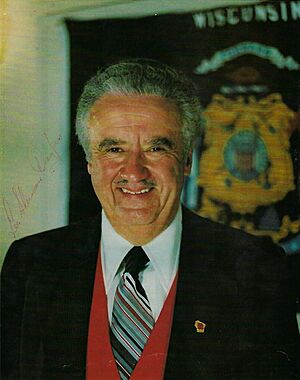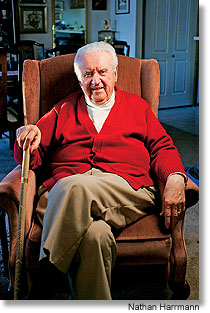Lee S. Dreyfus facts for kids
Quick facts for kids
Lee Dreyfus
|
|
|---|---|

Dreyfus as governor, c. 1979
|
|
| 40th Governor of Wisconsin | |
| In office January 4, 1979 – January 3, 1983 |
|
| Lieutenant | Russell Olson |
| Preceded by | Martin Schreiber |
| Succeeded by | Tony Earl |
| Personal details | |
| Born |
Lee Sherman Dreyfus
June 20, 1926 Milwaukee, Wisconsin, U.S. |
| Died | January 2, 2008 (aged 81) Waukesha, Wisconsin, U.S. |
| Resting place | Prairie Home Cemetery Waukesha, Wisconsin, U.S. |
| Political party | Republican |
| Spouse |
Joyce Unke
(m. 1947) |
| Alma mater | University of Wisconsin–Madison |
| Occupation |
|
| Military service | |
| Allegiance | United States |
| Branch/service | United States Navy |
| Battles/wars | World War II |
Lee Sherman Dreyfus (June 20, 1926 – January 2, 2008) was an American teacher and politician. He was a member of the Republican Party. He served as the 40th governor of Wisconsin from 1979 to 1983. Before becoming governor, Dreyfus was the Chancellor of the University of Wisconsin–Stevens Point.
Contents
Lee Dreyfus's Early Life
Dreyfus was born and grew up in Milwaukee. His parents were Clare and Woods Orlow Dreyfus. He went to Washington High School. His father worked on the radio, and his mother was on the Milwaukee School Board for 25 years.
After high school, Dreyfus joined the United States Navy. He learned to be an electronics technician and fixed radar during World War II. After the war, he went to the University of Wisconsin–Madison. There, he met Joyce Unke, and they married in 1947. Dreyfus earned three degrees from the university, including a doctorate in communication in 1957.
Dreyfus's Career Journey
Academic Leadership and Teaching
Dreyfus started his career at Wayne State University in Detroit. He managed the radio station and helped create the mass communications department. In 1962, he returned to Madison. He became the manager of WHA-TV and a professor.
In 1967, Dreyfus became the president of Wisconsin State University-Stevens Point. Later, it became the University of Wisconsin–Stevens Point. He was known for being easy to talk to. He often wore a red vest so students could easily spot him on campus.
Entering the World of Politics
A trip to China in 1975 changed Dreyfus's view on government. He saw the problems of a one-party system. This made him believe that having only one political party was not good for people.
In 1977, he joined the Republican Party. He felt the party needed help in Wisconsin. He decided to run for governor in 1978.
Dreyfus ran an unusual campaign. He traveled the state in a painted school bus. He called it "The Red Vest Whistle Stop Special." This helped him get attention from the media and connect with voters. The state Republican Party supported another candidate, Bob Kasten. But Dreyfus kept going.
He was a great speaker. He often said that states should make most of their own laws. He believed the federal government should only "defend our shores, deliver our mail and stay the hell out of our lives." He also famously said, "Madison, Wisconsin is 30 square miles surrounded by reality."
Dreyfus won the Republican primary election. Then, he defeated the acting governor, Martin Schreiber. He became Wisconsin's 40th governor.
Key Actions as Governor
As governor, Dreyfus was fiscally conservative. This means he focused on cutting taxes and making the government smaller. This was similar to the ideas of Ronald Reagan at the time. He wanted to lower Wisconsin's high income tax rates.
However, Dreyfus was socially moderate. In 1982, he signed a law that made it illegal to treat people unfairly in jobs and housing, ensuring everyone had equal opportunities. He said the government had "no business asking" certain questions.
Dreyfus was known for his strong speaking skills. He convinced voters he was the right person for the job. But his tax cuts led to problems. The state soon faced budget deficits, meaning it spent more money than it took in. This was due to high inflation and rising unemployment.
These budget problems led to cuts in services, like road maintenance. By 1982, the state had a large budget deficit and high unemployment. Dreyfus decided not to run for a second term.
One of his most important decisions was building a school of veterinary medicine at the University of Wisconsin–Madison. He believed it was important for research, even if the state didn't need more veterinarians at the time. This decision proved very important later for stem cell research.
Life After Public Service
Dreyfus chose not to run for re-election in 1982. He later said that politics was not his main interest.
After being governor, he worked for Sentry Insurance. He also served as Interim State Superintendent of Public Instruction. He was also on the University of Wisconsin Board of Regents.
In 1985, he started a consulting firm. He gave speeches and advised the state on education. He also wrote a weekly newspaper column for many years.
Health and Passing
In 2005, Dreyfus had heart problems after knee surgery. He had bypass surgery. His health declined after this, and he passed away in January 2008 from respiratory failure.
Recognizing Lee Dreyfus's Legacy
The Lee Sherman Dreyfus University Center at UW–Stevens Point was named after him in 2007. He was also honored by being elected to the Wisconsin Broadcasters' Hall of Fame.


